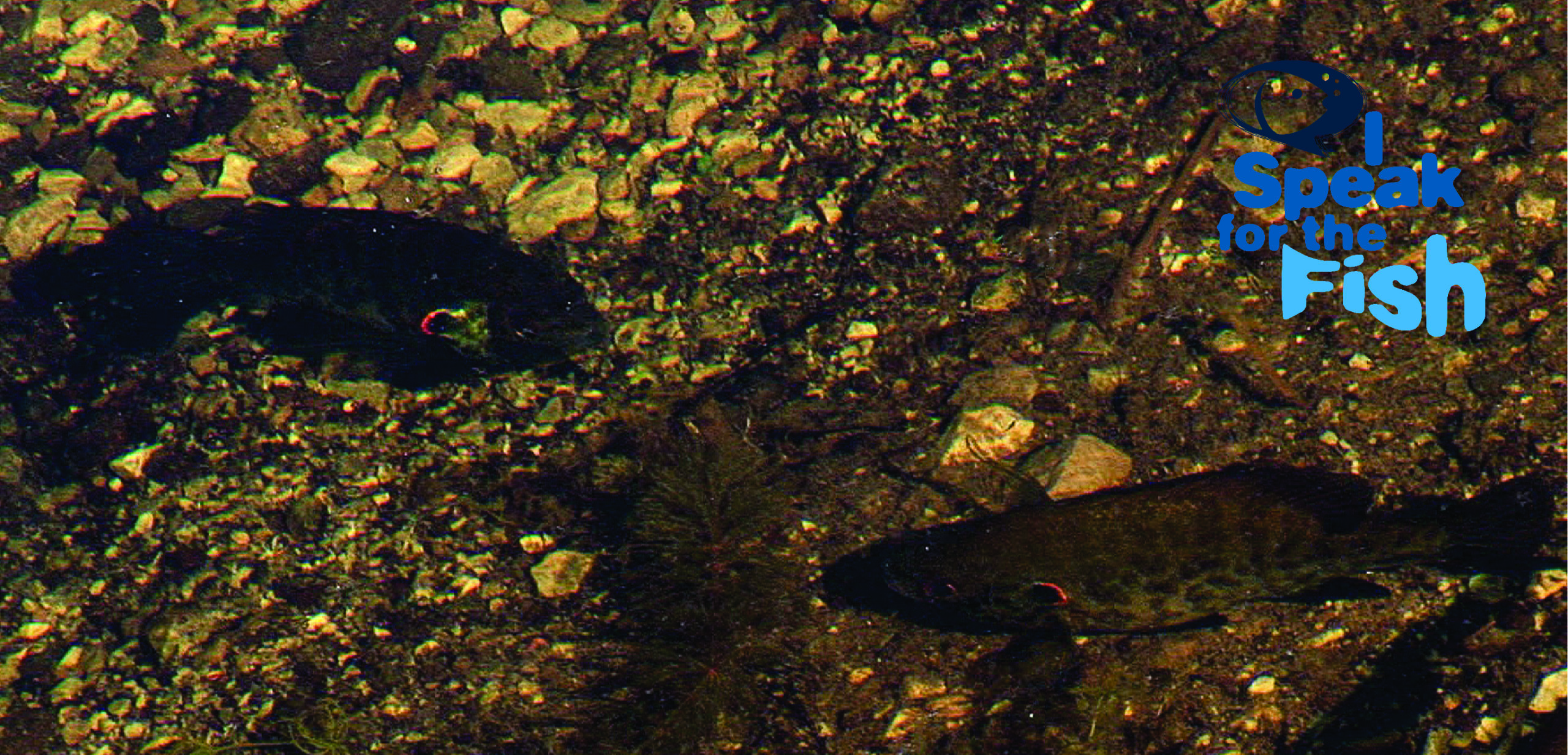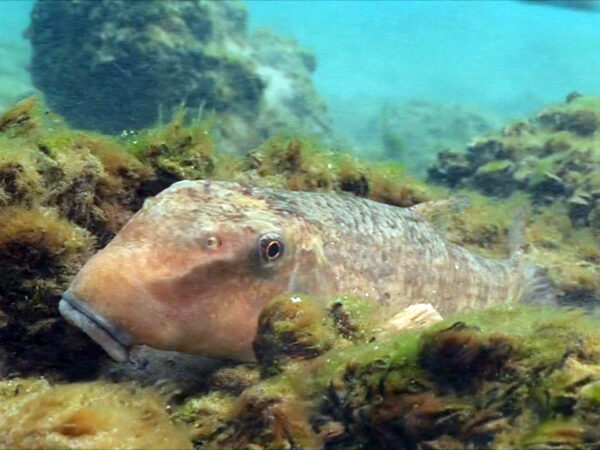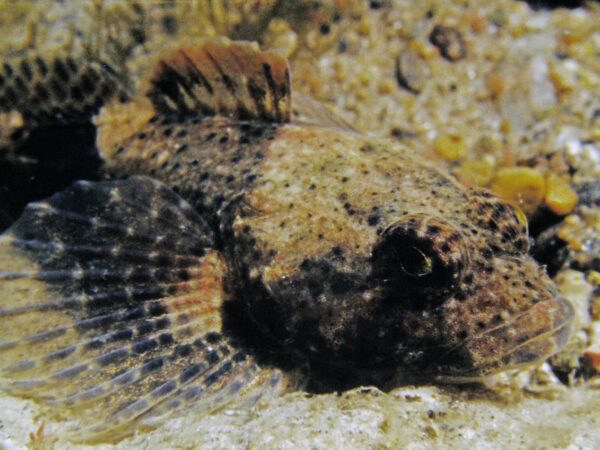
 I Speak for the Fish is a monthly column written by Great Lakes Now Contributor Kathy Johnson, coming out the third Monday of each month. Publishing the author’s views and assertions does not represent endorsement by Great Lakes Now or Detroit Public Television. Check out her previous columns.
I Speak for the Fish is a monthly column written by Great Lakes Now Contributor Kathy Johnson, coming out the third Monday of each month. Publishing the author’s views and assertions does not represent endorsement by Great Lakes Now or Detroit Public Television. Check out her previous columns.
For many fish, including lake sturgeon, there is no courtship or fanfare to spawning. Their reproductive success is based purely on volume. They put hundreds of thousands of fertilized eggs into the system, banking on a few to survive.
Sunfish take a completely different approach with elaborate courtship and nesting behaviors. And their helicopter parenting skills result in a very high survival rate for their offspring.
Sunfish are generally round and thin like large fluffy pancakes. Their name likely originates from their circular shape and ability to reflect the sun in shallow water where they nest.
They are not great swimmers as they rely primarily on their pectoral fins to maneuver their saucer-shaped bodies through the water. Not surprisingly, they prefer quiet ponds with lots of vegetation.
I have seen sunfish nesting in multiple locations but my favorite spot is actually behind a Walmart superstore. An active wetland was bulldozed to make way for the big box store and a 10-acre pond was created as part of Walmart’s remediation agreement.
A decade later turtles bask on fallen logs while green herons stalk frogs from the shelter of shoreline reeds. And each spring when the sunshine begins to warm the water, the sunfish gather for an award-winning performance.
Foreshadowing drought Sunfish were native only to the Eastern half of North America but as their popularity as a sportfish grew, they were introduced across the entire continent and even exported to Europe and Africa.
Bluegills are the most common but other members of the sunfish family found in the Great Lakes include greens, longears, warmouths and pumpkin seeds.
The list of common names for sunfish is extensive and varies significantly by region from bream (pronounced “brim”) in the South to panfish and sunnies in the North.
Sunfish are one of the most colorful families of freshwater fish. Pumpkin seeds are particularly beautiful with coppery spots on their sides and bellies dusted with 14-karat gold.
During spawning green sunfish males darken to a rich emerald and the markings on male bluegill become a dramatic sapphire blue. An average-sized adult bluegill is around seven inches. The world record is 16 inches.
Sunfish have teeth in their mouths and in their throats. But their mouths are very small so they often use a technique called suction feeding. By opening their mouths very quickly they can suck in small bugs and prey swimming in the water.
They also nip parasites off turtles.
Sunfish are like junkyard dogs that will eat almost anything. Their willingness to strike on nearly any bait is why they are often the first fish a new angler will catch. A worm, a string and a bent nail are essentially all that is needed to catch a sunfish making them an ideal entry-level sportfish. My tattered copy of Fishes of the Central United States offers some interesting sunfish-lore. The old-timers claim that bluegill can predict the weather and will choose the water depth for their nesting grounds accordingly.
If bluegill nest in mere inches of water this indicates they are anticipating water levels will increase. Conversely, when the fish move deeper and nest in several feet of water this is a portent of drought because they are expecting water levels to drop.

Sunfish. (Photo Credit: Greg Lashbrook/PolkaDot Perch)
Courting Rituals
I can sit and watch bluegill males forming their nesting colonies all day long. And sometimes I do.
Over the course of just a few days, the males will create a solid mat of circular nests on the bottom. The nests are typically about a foot in diameter and each is almost perfectly round. The males create their circular depressions by sweeping the sand, gravel and other debris away with their fins.
They also remove rocks by picking them up with their mouths and spitting them outside the circle. The largest males will fight to establish their nests at the center of the colony where the risk of predation is much lower.
The males secure and then defend their spots by chasing and biting the fins of rival males. Smaller males are constantly challenging the larger adults and the battles that ensue can become quite intense.
Once their nest is suitably prepared, the males must then compete for the females’ attention. They do this by swimming around their nests, flaring their fins and deepening their color. When a female enters the nest, she and the dominant male will circle each other nose to tail in a Ying-Yang formation.
When the female is ready, she lays on her side to release her eggs. And that is when the sneakers strike.
Sneakers are small males that are old enough to spawn but are far too small to win a nest site of their own. These males are small enough that the resident male does not perceive them as a threat and mostly tolerates their presence.
Sneakers follow the females around and hover at the perimeter of the nests. When the spawning begins, the sneakers dash into the nest and attempt to fertilize some of the eggs.
Being sneaky is a huge advantage for small bluegills as it saves them from having to secure a nest site, compete for a female, guard the eggs or defend the hatchlings. But it only works for very small males.
Any medium to large males that approach a nest are perceived as a threat and they are immediately attacked by the resident male. So, satellites use a different technique to gain access. Satellites are medium-size male bluegill that mimic the behavior of females in order to enter nests and fertilize eggs. This includes lightening their color and laying on their sides when challenged by the resident male.
Female sunfish deposit their eggs in multiple nests over the course of a day or two.
Once a female or two have deposited eggs, the resident male will switch to guarding mode and he will attack any fish that enters his circle. The eggs hatch in three to five days and with such diligent parenting the survival rate is very high.

Nesting sunfish. (Photo Credit: Greg Lashbrook/PolkaDot Perch)
Courting Stewardship
I have heard that sunfish are a gateway fish for angling as they are often the first fish that a child catches. But teaching children how to hook sunfish is only one path to lifelong stewardship.
For those of us who do not like to skewer worms or watch bobbers bob, observing sunfish nest is another way to enjoy nature and fish.
Occasionally, when I’m watching the bluegills nest at my favorite pond, others will pause to watch. Typically, they only look for about 30 seconds before walking away with a disappointed, “Just some bluegill.”
Or worse, they engage in rock throwing, stick poking and other Neanderthal behaviors.
But when I ask if they have ever seen a fish moving a rock or if they can guess which sneaker will be successful, suddenly they are as hooked as a fish on a line.
Sunfish offer a special opportunity for people, particularly families with children, to observe the entire reproductive process of a fish in the wild without getting wet.
Positive childhood experiences can spark a lifelong interest. And just as with fishing, igniting an interest in fish behaviors is as easy as visiting a pond and having the patience to sit quietly. No worms required.
Catch more news at Great Lakes Now:
I Speak for the Fish: These catfish have something to say
I Speak for the Fish: Water snakes are spooktacular
Featured image: Courting sunfish. (Photo Credit: Greg Lashbrook/PolkaDot Perch)




